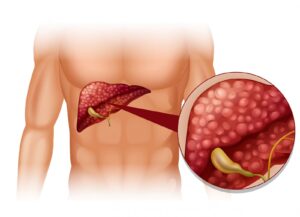
Is Cirrhosis Genetic? Exploring Inherited Liver Conditions
Liver diseases have become a growing concern for healthcare organizations worldwide, with an increasing prevalence attributed to factors such as sedentary lifestyles and alcohol consumption. According to the WHO (World Health Organization), liver diseases contribute to over 20 lakh deaths globally, with 4 lakh of these occurring in India alone. The India Liver Health Summit 2022, hosted by the Integrated Health & Wellbeing (IHW) Council, highlighted that 1 in 3 individuals in India is currently grappling with Fatty Liver disease. While lifestyle changes are significant contributors to the rise in liver diseases, genetics and heredity also play a crucial role in the transmission of certain liver conditions. This article delves into genetically transferred liver diseases, exploring their causes and implications.
Liver Diseases That Are Genetically Transferred
Hemochromatosis
Hemochromatosis is a genetic disorder characterized by excessive absorption of dietary iron by the intestines. This leads to the accumulation of iron in various organs, including the liver, pancreas, and heart. The condition is primarily caused by mutations in the HFE gene, which regulates the absorption of iron from food. Individuals with hemochromatosis may experience symptoms such as fatigue, joint pain, and abdominal discomfort. If left untreated, the excess iron can damage the liver, leading to cirrhosis and an increased risk of liver cancer.
Symptoms of Hemochromatosis
- Fatigue;
- Joint pain;
- Abdominal pain;
- Loss of libido;
- Bronze or gray skin coloration.
Treatment Options
- Phlebotomy (blood removal);
- Iron chelation therapy;
- Dietary modifications (limiting iron-rich foods).
Wilson’s Disease
Wilson’s disease is a rare inherited disorder that causes copper to accumulate in various organs, particularly the liver and brain. This condition results from mutations in the ATP7B gene, which is responsible for regulating copper levels in the body. Excessive copper buildup can lead to liver damage, neurological symptoms, and psychiatric disturbances. Without proper treatment, Wilson’s disease can progress to liver failure and other life-threatening complications.
Symptoms of Wilson’s Disease
- Jaundice;
- Abdominal pain;
- Tremors;
- Behavioral changes;
- Kayser-Fleischer rings (copper deposits in the eyes).
Treatment Options
- Copper-chelating medications;
- Zinc supplements;
- Liver transplantation in severe cases.
Alpha-1 Antitrypsin Deficiency
Alpha-1 antitrypsin deficiency is a genetic disorder that impairs the liver’s ability to produce a protein called alpha-1 antitrypsin. This protein plays a crucial role in protecting the lungs from damage caused by enzymes released during inflammation. In individuals with this deficiency, the abnormal protein accumulates in the liver, leading to liver disease and an increased risk of cirrhosis. Symptoms of alpha-1 antitrypsin deficiency can vary widely, ranging from mild respiratory issues to severe liver damage.
Symptoms of Alpha-1 Antitrypsin Deficiency
- Shortness of breath;
- Wheezing;
- Chronic obstructive pulmonary disease (COPD);
- Liver cirrhosis;
- Elevated liver enzymes.
Treatment Options
- Supportive care for lung symptoms;
- Liver transplant in advanced cases.

How to Reduce The Risk of Liver Disease?
Maintaining a healthy lifestyle and making proactive choices can significantly reduce the risk of developing diseases related to the body’s detoxification organ, whether inherited or acquired. Here are some key strategies to promote the health of this vital organ:
- Healthy Diet: Consume a balanced diet rich in fruits, vegetables, whole grains, and lean proteins. Limit intake of processed foods, sugary beverages, and saturated fats;
- Regular Exercise: Engage in regular physical activity to maintain a healthy weight and reduce the risk of fatty liver disease;
- Limit Alcohol Intake: Excessive alcohol consumption can contribute to liver damage. It is essential to moderate alcohol consumption or abstain altogether to protect liver health;
- Routine Medical Check-ups: Regular health screenings can help detect liver diseases at an early stage, allowing for timely intervention and management;
- Avoid Toxins: Minimize exposure to environmental toxins and chemicals that can harm liver function;
- Manage Chronic Conditions: Properly manage underlying health conditions such as diabetes, obesity, and high cholesterol, which can increase the risk of liver disease.
Conclusion
In conclusion, while diseases affecting the hepatic system can be influenced by a combination of lifestyle factors and genetic predisposition, understanding the role of genetics in certain conditions affecting this organ is crucial for early detection and effective management. By recognizing the signs of genetically transferred conditions affecting the hepatic system and adopting preventive measures, individuals can take proactive steps to safeguard their hepatic health and overall well-being. Through a holistic approach that encompasses healthy habits, regular monitoring, and genetic awareness, it is possible to mitigate the impact of hereditary conditions affecting the hepatic system and promote long-term health of this vital organ.

